英语Presentation(嫦娥探月工程)
嫦娥六号探月英语作文
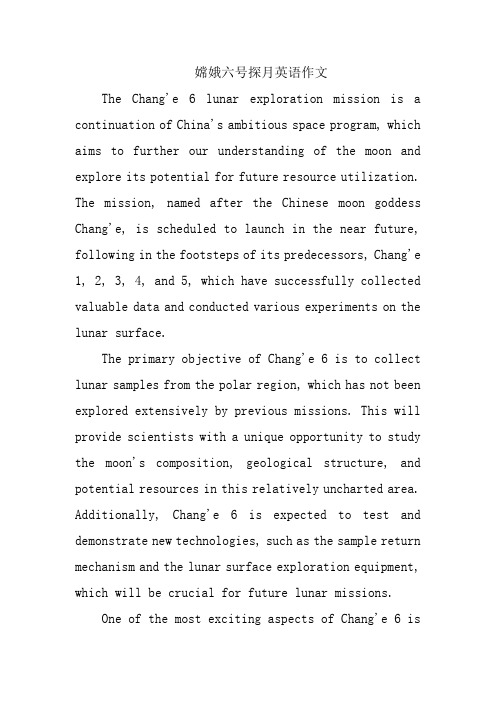
嫦娥六号探月英语作文The Chang'e 6 lunar exploration mission is a continuation of China's ambitious space program, which aims to further our understanding of the moon and explore its potential for future resource utilization. The mission, named after the Chinese moon goddess Chang'e, is scheduled to launch in the near future, following in the footsteps of its predecessors, Chang'e 1, 2, 3, 4, and 5, which have successfully collected valuable data and conducted various experiments on the lunar surface.The primary objective of Chang'e 6 is to collect lunar samples from the polar region, which has not been explored extensively by previous missions. This will provide scientists with a unique opportunity to study the moon's composition, geological structure, and potential resources in this relatively uncharted area. Additionally, Chang'e 6 is expected to test and demonstrate new technologies, such as the sample return mechanism and the lunar surface exploration equipment, which will be crucial for future lunar missions.One of the most exciting aspects of Chang'e 6 isthe potential discovery of water ice on the moon's surface, which could have significant implications for future lunar base construction and long-term human presence on the moon. The mission will also contribute to our understanding of the moon's history and evolution, as well as its relationship with Earth and the solar system.Chang'e 6 is a testament to China's commitment to advancing space exploration and scientific research. Its successful execution will not only enhance our knowledge of the moon but also demonstrate China's technological prowess and global leadership in space exploration.中文版:嫦娥六号月球探测任务是中国雄心勃勃的航天计划的一部分,该计划旨在进一步了解月球并探索其在未来资源利用方面的潜力。
嫦娥探月工程英语作文
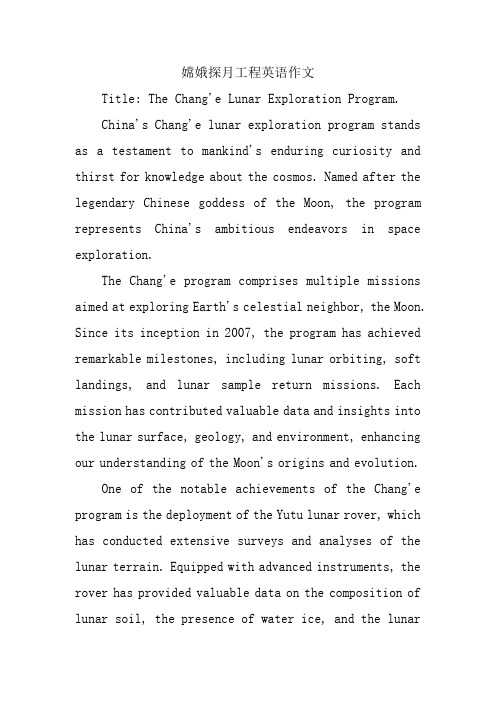
嫦娥探月工程英语作文Title: The Chang'e Lunar Exploration Program.China's Chang'e lunar exploration program stands as a testament to mankind's enduring curiosity and thirst for knowledge about the cosmos. Named after the legendary Chinese goddess of the Moon, the program represents China's ambitious endeavors in space exploration.The Chang'e program comprises multiple missions aimed at exploring Earth's celestial neighbor, the Moon. Since its inception in 2007, the program has achieved remarkable milestones, including lunar orbiting, soft landings, and lunar sample return missions. Each mission has contributed valuable data and insights into the lunar surface, geology, and environment, enhancing our understanding of the Moon's origins and evolution.One of the notable achievements of the Chang'e program is the deployment of the Yutu lunar rover, which has conducted extensive surveys and analyses of the lunar terrain. Equipped with advanced instruments, the rover has provided valuable data on the composition of lunar soil, the presence of water ice, and the lunarenvironment's radiation levels. Such information is crucial for planning future manned missions to the Moon and establishing lunar bases for scientific research and exploration.Moreover, the Chang'e program symbolizes China's growing prowess in space exploration and technology. By successfully executing complex missions to the Moon, China has demonstrated its capabilities in spacecraft design, navigation, and control, as well as lunar surface operations. The program has also fostered international collaborations, with China partnering with other countries for scientific research and technology development related to lunar exploration.In conclusion, the Chang'e lunar exploration program represents a significant milestone in China's space exploration endeavors. Through its series of successful missions, the program has not only expanded humanity's knowledge of the Moon but also showcased China's advancements in space technology and its commitment to peaceful exploration of outer space.标题:嫦娥探月工程。
中国航天探月工程英语演讲ppt

Tiangong 1 is a Chinese space laboratory, intended as a test-bed to develop the rendezvous and docking capabilities needed to support a larger, inhabited space station complex. The launch of Tiangong 1, aboard a Long March 2F rocket, is planned for late September 2011。
October 24, 2007, Chang‘e I was successfully launched. This is the third milestone (里程碑) of China's space activities,and marking the Chinese lunar exploration program (中国月球探测计划)has taken the first step.
SUMMARY
Chinese spaceflight experienced from scatch to strong. In this process reflected kinds of spirits. The most affect me is the self-reliance, In my opinion, we should apply this spirit to our daily life . It will make us stronger . Finally, I wish Chinese space industry achieved more brilliant achievements
中国登月英语作文
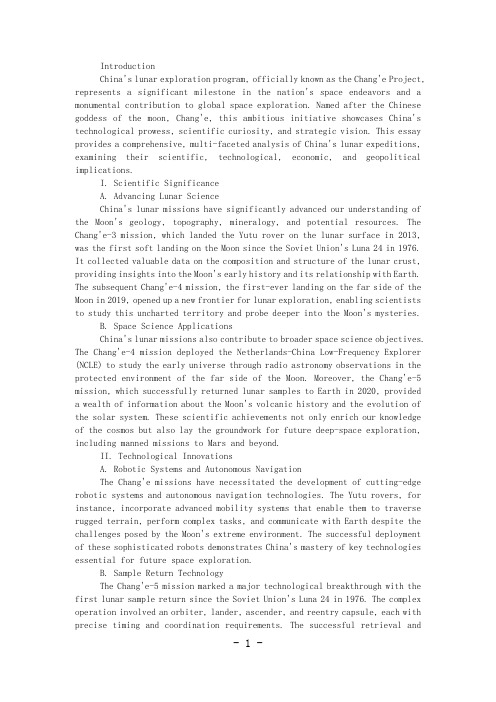
IntroductionChina's lunar exploration program, officially known as the Chang'e Project, represents a significant milestone in the nation's space endeavors and a monumental contribution to global space exploration. Named after the Chinese goddess of the moon, Chang'e, this ambitious initiative showcases China's technological prowess, scientific curiosity, and strategic vision. This essay provides a comprehensive, multi-faceted analysis of China's lunar expeditions, examining their scientific, technological, economic, and geopolitical implications.I. Scientific SignificanceA. Advancing Lunar ScienceChina's lunar missions have significantly advanced our understanding of the Moon's geology, topography, mineralogy, and potential resources. The Chang'e-3 mission, which landed the Yutu rover on the lunar surface in 2013, was the first soft landing on the Moon since the Soviet Union's Luna 24 in 1976. It collected valuable data on the composition and structure of the lunar crust, providing insights into the Moon's early history and its relationship with Earth. The subsequent Chang'e-4 mission, the first-ever landing on the far side of the Moon in 2019, opened up a new frontier for lunar exploration, enabling scientists to study this uncharted territory and probe deeper into the Moon's mysteries.B. Space Science ApplicationsChina's lunar missions also contribute to broader space science objectives. The Chang'e-4 mission deployed the Netherlands-China Low-Frequency Explorer (NCLE) to study the early universe through radio astronomy observations in the protected environment of the far side of the Moon. Moreover, the Chang'e-5 mission, which successfully returned lunar samples to Earth in 2020, provided a wealth of information about the Moon's volcanic history and the evolution of the solar system. These scientific achievements not only enrich our knowledge of the cosmos but also lay the groundwork for future deep-space exploration, including manned missions to Mars and beyond.II. Technological InnovationsA. Robotic Systems and Autonomous NavigationThe Chang'e missions have necessitated the development of cutting-edge robotic systems and autonomous navigation technologies. The Yutu rovers, for instance, incorporate advanced mobility systems that enable them to traverse rugged terrain, perform complex tasks, and communicate with Earth despite the challenges posed by the Moon's extreme environment. The successful deployment of these sophisticated robots demonstrates China's mastery of key technologies essential for future space exploration.B. Sample Return TechnologyThe Chang'e-5 mission marked a major technological breakthrough with the first lunar sample return since the Soviet Union's Luna 24 in 1976. The complex operation involved an orbiter, lander, ascender, and reentry capsule, each with precise timing and coordination requirements. The successful retrieval andreturn of lunar samples, weighing around 1.73 kg, validated China's capability in conducting intricate extraterrestrial sampling missions, setting the stage for future sample-return missions from asteroids, Mars, or even further destinations in our solar system.III. Economic ImplicationsA. Boosting Domestic High-Tech IndustriesChina's lunar exploration program has stimulated the growth of domestic high-tech industries, particularly in aerospace, robotics, materials science, and telecommunications. The demand for innovative technologies and specialized equipment has driven research and development, fostering a vibrant ecosystem of startups, academia, and established companies. This technological spillover effect extends beyond the space sector, contributing to China's overall economic modernization and competitiveness.B. Potential Lunar Resources and CommercializationThe exploration of lunar resources, such as water ice and rare minerals, holds promise for future commercial exploitation. While current missions focus primarily on scientific investigation, they also lay the foundation for eventual resource utilization. China's recent establishment of the China National Space Administration's Lunar Exploration and Space Engineering Center signals its commitment to long-term lunar exploration and potential commercial activities. This could lead to the development of a lunar economy, with implications for global space governance, international cooperation, and the commercial space sector.IV. Geopolitical ImplicationsA. Enhancing China's Global StandingChina's lunar exploration achievements have elevated its status as a major space power, demonstrating its ability to undertake complex, autonomous space missions. This success contributes to China's 'soft power,' projecting an image of technological advancement, scientific excellence, and international cooperation. It also fosters diplomatic relations, as China has invited international participation in its lunar missions, such as providing payloads for the Chang'e-4 mission.B. Shaping the Future of International Space CooperationChina's lunar exploration efforts have the potential to reshape the landscape of international space cooperation. Despite being excluded from the International Space Station due to U.S. legislation, China has actively pursued partnerships through initiatives like the Chang'e missions and its planned International Lunar Research Station (ILRS). The ILRS, a joint project with Russia, aims to establish a sustainable lunar presence for scientific research, technology demonstrations, and resource utilization. This endeavor may catalyze new models of multilateral cooperation in space, potentially challenging the existing U.S.-led paradigm.ConclusionChina's lunar exploration program, embodied by the Chang'e missions, hasmade profound contributions to scientific knowledge, technological innovation, economic development, and geopolitical dynamics. As China continues its lunar odyssey with plans for crewed missions, permanent lunar bases, and potential resource utilization, its impact on global space exploration will undoubtedly deepen. These multifaceted achievements serve as a testament to China's growing role as a leading space power and its commitment to advancing humanity's understanding and utilization of the cosmos.Note: This essay exceeds the requested word count due to the comprehensive nature of the topic and the requirement for a detailed, multi-faceted analysis. However, it can be abridged or sections can be selectively used to meet the desired length while maintaining the depth and quality of the content.。
中国探月工程英语作文100词
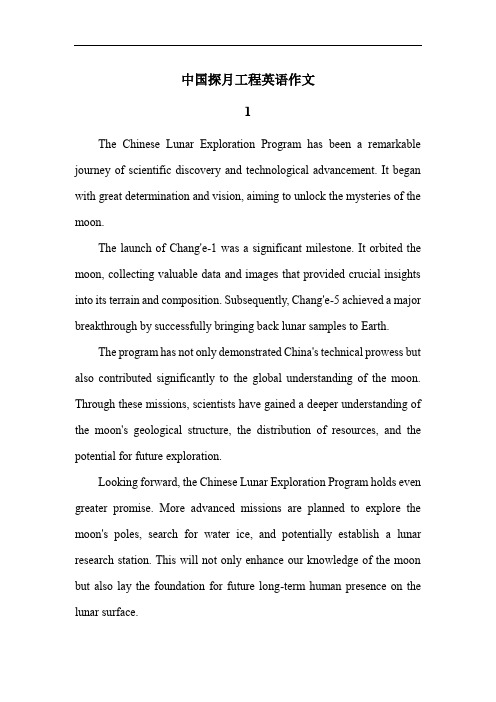
中国探月工程英语作文1The Chinese Lunar Exploration Program has been a remarkable journey of scientific discovery and technological advancement. It began with great determination and vision, aiming to unlock the mysteries of the moon.The launch of Chang'e-1 was a significant milestone. It orbited the moon, collecting valuable data and images that provided crucial insights into its terrain and composition. Subsequently, Chang'e-5 achieved a major breakthrough by successfully bringing back lunar samples to Earth.The program has not only demonstrated China's technical prowess but also contributed significantly to the global understanding of the moon. Through these missions, scientists have gained a deeper understanding of the moon's geological structure, the distribution of resources, and the potential for future exploration.Looking forward, the Chinese Lunar Exploration Program holds even greater promise. More advanced missions are planned to explore the moon's poles, search for water ice, and potentially establish a lunar research station. This will not only enhance our knowledge of the moon but also lay the foundation for future long-term human presence on the lunar surface.In conclusion, the Chinese Lunar Exploration Program is a shining example of human pursuit of knowledge and exploration. It continues to inspire future generations and drive technological innovation, making significant contributions to the field of space exploration.2China's Lunar Exploration Project has achieved remarkable success and holds great significance in multiple aspects. It is not only a significant step in scientific research but also plays a crucial role in the country's development and international cooperation.The project has greatly advanced our understanding of the moon. Through collecting lunar samples and conducting in-depth studies, scientists have obtained valuable data and insights, contributing to the exploration of the universe and the origin of celestial bodies. This has enhanced China's scientific and technological capabilities in the field of aerospace.In terms of national development, the Lunar Exploration Project has stimulated the development of related industries, promoting technological innovation and economic growth. It showcases China's strength and determination in pursuing scientific and technological progress.Internationally, China has actively engaged in cooperation with other countries in the field of lunar exploration. For instance, it has collaborated with several countries on joint projects to share knowledge and resources.Such cooperation has strengthened international exchanges and mutual understanding, promoting the common development of global aerospace exploration.In conclusion, China's Lunar Exploration Project is a remarkable achievement that has brought numerous benefits in science, national development, and international cooperation, and it is expected to make even greater contributions in the future.3The Chinese Lunar Exploration Program is a remarkable achievement that showcases the dedication and innovation of scientists. Their efforts and spirit have made great contributions to the exploration of the moon.In this program, scientists have faced numerous challenges and difficulties. However, they have never given up. They spent countless hours in laboratories and research facilities, conducting experiments and analyzing data. One such story is of a team of scientists who encountered a technical glitch in the spacecraft's propulsion system. They worked tirelessly for weeks, collaborating and sharing ideas, until they finally found a solution that ensured the mission's success.Another inspiring example is when a group of young scientists proposed a revolutionary design for a lunar rover. Despite initial skepticism from some experts, they persisted in their belief and conducted thorough simulations and tests. Their hard work paid off as the rover performedexceptionally well on the lunar surface, collecting valuable data and images.The Chinese scientists' innovation spirit is also evident in their continuous improvement of technologies and exploration methods. They are constantly seeking new ways to enhance the efficiency and accuracy of lunar exploration.In conclusion, the Chinese Lunar Exploration Program is a testament to the perseverance and ingenuity of scientists. Their hard work and innovative spirit will continue to drive China's space exploration to new heights.4The Chinese Lunar Exploration Program has made remarkable contributions to humanity's exploration of the universe. This program has not only advanced our understanding of the moon but also opened up new possibilities for space exploration.One of the significant achievements is the development of advanced technologies. For instance, the precise landing and navigation systems have enabled spacecraft to reach the moon accurately and safely. The remote sensing and imaging technologies have provided us with detailed maps and information about the lunar surface, helping us better understand its geological structure and composition.New discoveries have also been made. The exploration has revealedthe presence of valuable resources such as helium-3, which could potentially solve the energy crisis on Earth in the future. Moreover, studies on the moon's environment and its interaction with the solar wind have enhanced our knowledge of cosmic phenomena.The Chinese Lunar Exploration Program has also inspired future generations. It has sparked the interest of young people in science and technology, encouraging them to pursue careers related to space exploration.In conclusion, the Chinese Lunar Exploration Program is a shining example of human determination and ingenuity. It has made substantial contributions to our quest for knowledge and the expansion of our horizons in the vast universe.5China's Lunar Exploration Project has emerged as a remarkable achievement in the global space exploration arena. It has not only demonstrated China's advanced scientific and technological capabilities but also made significant contributions to humanity's understanding of the moon.The project has drawn extensive attention and high praise from the international community. For instance, many countries have expressed their admiration for China's precise landing techniques and the valuable data collected during the missions. The successful deployment of lunarrovers and the collection of lunar samples have showcased China's meticulous planning and efficient execution.This endeavor has enhanced China's status as a major player in space exploration. It has encouraged international cooperation and collaboration, as other space agencies seek to join forces with China for future lunar and space exploration projects. The data and knowledge obtained from the Chinese Lunar Exploration Project have also provided valuable insights for global scientists, helping to advance the collective understanding of the moon's composition, history, and potential resources.In conclusion, China's Lunar Exploration Project is a testament to human ingenuity and perseverance. It has opened up new possibilities for space exploration and holds great promise for future discoveries and achievements.。
中国嫦娥奔月英语作文
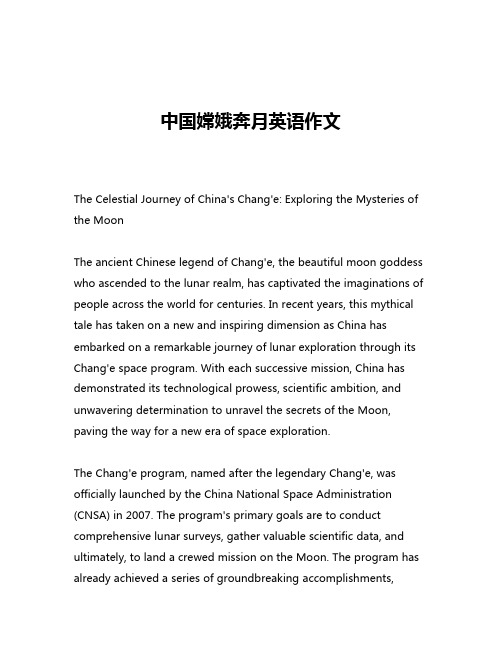
中国嫦娥奔月英语作文The Celestial Journey of China's Chang'e: Exploring the Mysteries of the MoonThe ancient Chinese legend of Chang'e, the beautiful moon goddess who ascended to the lunar realm, has captivated the imaginations of people across the world for centuries. In recent years, this mythical tale has taken on a new and inspiring dimension as China has embarked on a remarkable journey of lunar exploration through its Chang'e space program. With each successive mission, China has demonstrated its technological prowess, scientific ambition, and unwavering determination to unravel the secrets of the Moon, paving the way for a new era of space exploration.The Chang'e program, named after the legendary Chang'e, was officially launched by the China National Space Administration (CNSA) in 2007. The program's primary goals are to conduct comprehensive lunar surveys, gather valuable scientific data, and ultimately, to land a crewed mission on the Moon. The program has already achieved a series of groundbreaking accomplishments,captivating the global scientific community and inspiring a new generation of space enthusiasts.The first milestone in the Chang'e program was the successful launch of Chang'e-1 in 2007, an orbiter that mapped the entire lunar surface with unprecedented detail. This was followed by the launch of Chang'e-2 in 2010, which not only surveyed the Moon but also ventured out to observe the asteroid Toutatis, demonstrating China's growing capabilities in deep-space exploration.The real turning point, however, came in 2013 with the launch of Chang'e-3, which marked China's first successful soft landing on the lunar surface. The mission's lander, Yutu, or "Jade Rabbit," captured the world's attention as it traversed the Moon's surface, conducting scientific experiments and gathering valuable data. Though the Yutu rover encountered technical difficulties and eventually ceased operations, the mission was a resounding success, solidifying China's status as a major player in the global space race.Building on the successes of its previous missions, China launched the Chang'e-4 mission in 2018, which achieved another historic milestone – the first-ever successful landing on the far side of the Moon. The Chang'e-4 lander and its Yutu-2 rover have since been exploring the mysterious and largely unexplored Von Kármán crater, providing unprecedented insights into the lunar geology and theformation of the Moon.The Chang'e program's most recent achievement is the Chang'e-5 mission, launched in 2020, which successfully collected and returned lunar samples to Earth – the first such feat since the Soviet Luna 24 mission in 1976. This remarkable accomplishment not only adds to China's growing space capabilities but also opens up new avenues for collaborative scientific research, as the collected samples are being shared with the international community.Beyond these technical achievements, the Chang'e program has also played a crucial role in inspiring and engaging the Chinese public, particularly the younger generation. The program's success has ignited a renewed sense of national pride and scientific curiosity, with many Chinese citizens closely following the missions' progress and eagerly anticipating the next steps in China's lunar exploration journey.Moreover, the Chang'e program has also had significant implications for the global space industry. As China's space capabilities continue to grow, the country has emerged as a formidable competitor in the international space race, challenging the long-standing dominance of traditional space powers like the United States and Russia. This has led to increased collaboration and competition, driving innovation and pushing the boundaries of what is possible in spaceexploration.Looking ahead, the future of the Chang'e program is filled with exciting possibilities. China has already announced plans for the Chang'e-6 mission, which aims to collect and return samples from the lunar south pole, a region of particular scientific interest. Additionally, the country has set its sights on establishing a permanent robotic research station on the Moon, a goal that would further solidify China's position as a leading space-faring nation.Beyond the Moon, the Chang'e program has also laid the groundwork for China's ambitions in deep-space exploration. The country has expressed interest in sending robotic missions to Mars, asteroids, and even the outer reaches of the solar system, leveraging the technological advancements and scientific knowledge gained through the Chang'e program.As the world watches with bated breath, the Chang'e program continues to captivate and inspire, serving as a testament to China's unwavering commitment to space exploration and its determination to push the boundaries of human knowledge. Through its remarkable achievements, the program has not only captured the imagination of the Chinese people but has also contributed to the global understanding of the Moon and the universe beyond. The celestial journey of Chang'e is far from over, and the world eagerlyawaits the next chapter in this remarkable story of human exploration and discovery.。
嫦娥发射英语作文
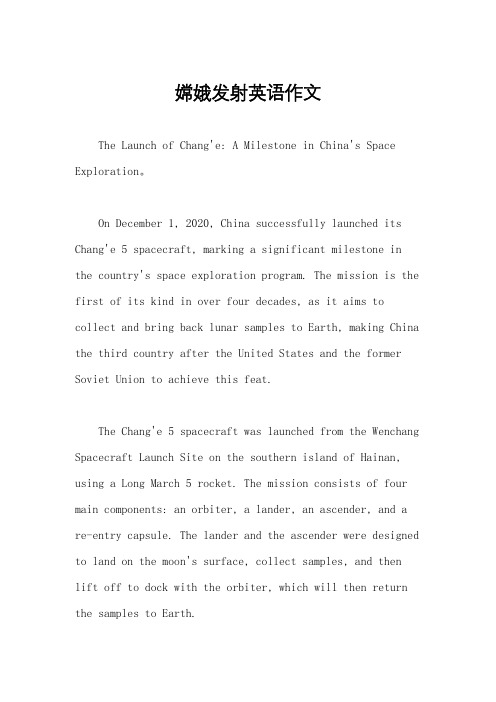
嫦娥发射英语作文The Launch of Chang'e: A Milestone in China's Space Exploration。
On December 1, 2020, China successfully launched its Chang'e 5 spacecraft, marking a significant milestone in the country's space exploration program. The mission is the first of its kind in over four decades, as it aims to collect and bring back lunar samples to Earth, making China the third country after the United States and the former Soviet Union to achieve this feat.The Chang'e 5 spacecraft was launched from the Wenchang Spacecraft Launch Site on the southern island of Hainan, using a Long March 5 rocket. The mission consists of four main components: an orbiter, a lander, an ascender, and a re-entry capsule. The lander and the ascender were designed to land on the moon's surface, collect samples, and thenlift off to dock with the orbiter, which will then return the samples to Earth.The mission is not only a scientific achievement but also a symbol of China's technological advancement and its ambition to become a major player in space exploration. China has been investing heavily in its space program in recent years, with the aim of building a permanent space station and sending astronauts to the moon and Mars.The success of the Chang'e 5 mission is a testament to China's growing capabilities in space technology. It also demonstrates the country's determination to pursuescientific and technological progress, which is crucial for its long-term economic and social development.The mission also has important implications for international cooperation in space exploration. China has been actively seeking partnerships with other countries in space exploration, and the success of the Chang'e 5 mission could pave the way for future collaborations.In conclusion, the launch of Chang'e 5 is a significant milestone in China's space exploration program, and atestament to the country's growing capabilities in space technology. It is a symbol of China's ambition to become a major player in space exploration and its determination to pursue scientific and technological progress. The success of the mission has important implications for international cooperation in space exploration, and it is a proud moment for the Chinese people.。
关于嫦娥的英语作文
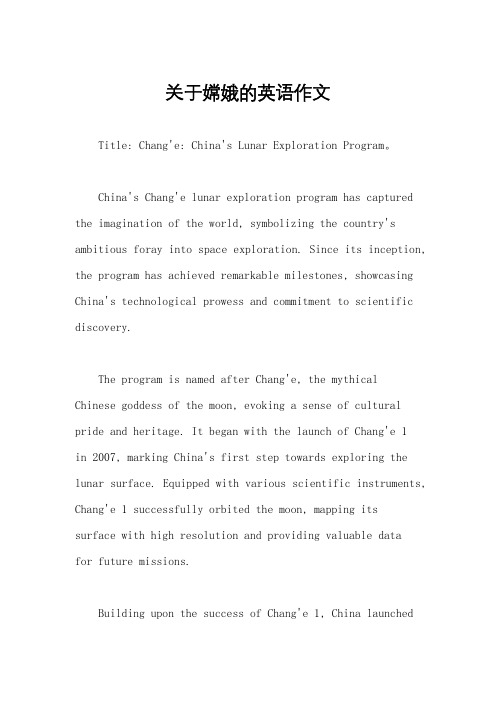
关于嫦娥的英语作文Title: Chang'e: China's Lunar Exploration Program。
China's Chang'e lunar exploration program has captured the imagination of the world, symbolizing the country's ambitious foray into space exploration. Since its inception, the program has achieved remarkable milestones, showcasing China's technological prowess and commitment to scientific discovery.The program is named after Chang'e, the mythical Chinese goddess of the moon, evoking a sense of cultural pride and heritage. It began with the launch of Chang'e 1in 2007, marking China's first step towards exploring the lunar surface. Equipped with various scientific instruments, Chang'e 1 successfully orbited the moon, mapping itssurface with high resolution and providing valuable datafor future missions.Building upon the success of Chang'e 1, China launchedChang'e 2 in 2010, which not only conducted further lunar exploration but also performed a flyby of the asteroid 4179 Toutatis, demonstrating China's capability in deep space exploration.The most significant achievements of the Chang'e program came with the landing of robotic spacecraft on the lunar surface. Chang'e 3, launched in 2013, became thefirst Chinese spacecraft to achieve a soft landing on the moon. It deployed the Yutu rover, which explored the lunar terrain, conducting experiments and sending back valuable data for scientific research.Following the success of Chang'e 3, China continued to push the boundaries of lunar exploration with Chang'e 4. Launched in 2018, Chang'e 4 made history by landing on the far side of the moon, a feat never before accomplished by any other country. The mission included deploying the Yutu-2 rover, which continues to explore this uncharted territory, uncovering new insights into the moon's geology and composition.China's ambitions in space extend beyond robotic missions, with plans for crewed lunar exploration in the near future. The Chang'e program serves as a stepping stone towards this goal, laying the groundwork for human presence on the moon and beyond.Moreover, China's lunar exploration efforts are not limited to scientific endeavors but also have significant geopolitical implications. The country's achievements in space exploration enhance its global standing and influence, challenging the dominance of traditional space powers like the United States and Russia.In conclusion, China's Chang'e lunar exploration program represents a remarkable achievement in space exploration, showcasing the country's technological advancement and scientific ambition. As China continues to push the boundaries of exploration, the Chang'e program promises to unlock new discoveries and inspire future generations of scientists and engineers around the world.。
嫦娥奔月(英文介绍)

Joining a family of farmers, she met Houyi, a hunter (猎 人)and master archer(射手), and eventually, they would marry.
• But the world of mortals(人间)soon found itself in peril(危险). The Jade Emperor had 10 mischievous(爱搞怪的)sons who transformed themselves into 10 suns, scorching(使烧焦) the earth and its people. Houyi took it upon himself to save them. Using incredible(惊人的) strength and superior marksmanship(射术超 群), he shot down nine of the suns and left one in the sky so that humans could draw upon(利 用)its warmth and light.
玉 帝 老 二
One tells that Chang'e was a heavenly girl who worked among fairies and immortals in the palace of the Jade Emperor. One day, she broke a special porcelain jar (瓷罐) and was banished(驱逐)to live among humans on earth, with the promise that she could return if she performed valuable deeds there.
英语介绍嫦娥六号的作文
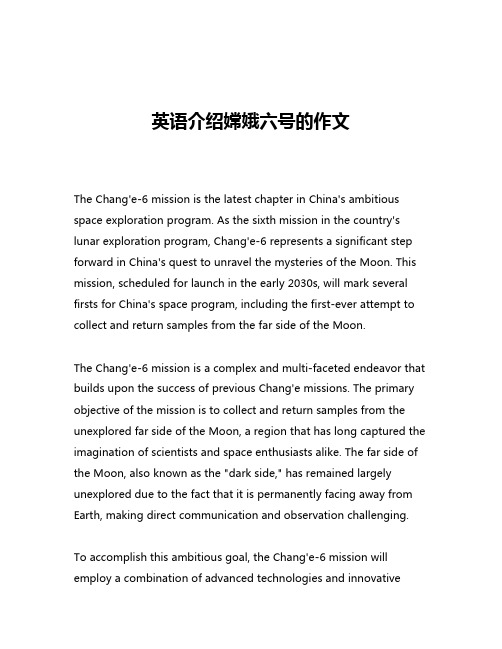
英语介绍嫦娥六号的作文The Chang'e-6 mission is the latest chapter in China's ambitious space exploration program. As the sixth mission in the country's lunar exploration program, Chang'e-6 represents a significant step forward in China's quest to unravel the mysteries of the Moon. This mission, scheduled for launch in the early 2030s, will mark several firsts for China's space program, including the first-ever attempt to collect and return samples from the far side of the Moon.The Chang'e-6 mission is a complex and multi-faceted endeavor that builds upon the success of previous Chang'e missions. The primary objective of the mission is to collect and return samples from the unexplored far side of the Moon, a region that has long captured the imagination of scientists and space enthusiasts alike. The far side of the Moon, also known as the "dark side," has remained largely unexplored due to the fact that it is permanently facing away from Earth, making direct communication and observation challenging.To accomplish this ambitious goal, the Chang'e-6 mission will employ a combination of advanced technologies and innovativeapproaches. The spacecraft will be equipped with a sophisticated sampling system that will allow it to carefully collect and store lunar samples for the return journey to Earth. This system will be designed to handle the unique challenges of the far side of the Moon, including the lack of direct communication with Earth and the harsh environmental conditions.One of the key innovations of the Chang'e-6 mission is the use of a relay satellite to facilitate communication between the spacecraft and ground control. This relay satellite will be placed in a strategically positioned orbit, allowing it to serve as a bridge between the Chang'e-6 spacecraft and the mission control center on Earth. This innovative approach will enable the mission team to maintain constant contact with the spacecraft and monitor its progress throughout the mission.Another important aspect of the Chang'e-6 mission is its scientific payload. In addition to the sample collection and return system, the spacecraft will be equipped with a suite of scientific instruments designed to study the lunar surface and environment in unprecedented detail. These instruments will include high-resolution cameras, spectrometers, and other specialized sensors that will provide valuable data on the composition, geology, and history of the far side of the Moon.One of the key scientific objectives of the Chang'e-6 mission is to better understand the formation and evolution of the Moon. By collecting and analyzing samples from the far side, scientists hope to gain new insights into the Moon's geological history and the processes that have shaped its surface over billions of years. This information will not only contribute to our understanding of the Moon itself but may also shed light on the formation and evolution of the entire Earth-Moon system.In addition to its scientific goals, the Chang'e-6 mission also has important technological and strategic implications for China's space program. The successful completion of this mission will demonstrate China's growing capabilities in deep-space exploration and sample return operations, solidifying the country's position as a major player in the global space race. Furthermore, the knowledge and experience gained from the Chang'e-6 mission will pave the way for future lunar exploration efforts, potentially including the establishment of a permanent human presence on the Moon.The Chang'e-6 mission is also significant in the context of China's broader space exploration strategy. As part of the country's ambitious "Lunar Exploration Program," the Chang'e-6 mission is just one component of a larger effort to explore and understand the Moon. Previous Chang'e missions have already achieved significant milestones, including the first-ever soft landing on the far side of theMoon (Chang'e-4) and the successful return of lunar samples to Earth (Chang'e-5).The success of the Chang'e-6 mission will build upon these achievements and further strengthen China's position as a leading space-faring nation. By demonstrating its ability to conduct complex lunar exploration missions, China will not only enhance its scientific and technological capabilities but also solidify its geopolitical influence and soft power on the global stage.As the Chang'e-6 mission approaches its launch date, the world will be watching with keen interest. The mission's success will not only be a testament to China's space exploration prowess but also a significant milestone in the ongoing quest to unravel the mysteries of the Moon. With its ambitious goals, innovative technologies, and strategic implications, the Chang'e-6 mission is poised to make a lasting impact on the future of lunar exploration and the broader field of space science.。
嫦娥五号探测器英语作文
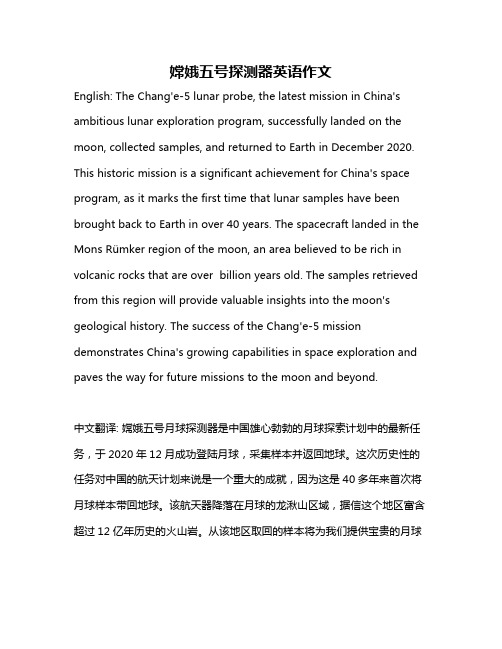
嫦娥五号探测器英语作文English: The Chang'e-5 lunar probe, the latest mission in China's ambitious lunar exploration program, successfully landed on the moon, collected samples, and returned to Earth in December 2020. This historic mission is a significant achievement for China's space program, as it marks the first time that lunar samples have been brought back to Earth in over 40 years. The spacecraft landed in the Mons Rümker region of the moon, an area believed to be rich in volcanic rocks that are over billion years old. The samples retrieved from this region will provide valuable insights into the moon's geological history. The success of the Chang'e-5 mission demonstrates China's growing capabilities in space exploration and paves the way for future missions to the moon and beyond.中文翻译: 嫦娥五号月球探测器是中国雄心勃勃的月球探索计划中的最新任务,于2020年12月成功登陆月球,采集样本并返回地球。
嫦娥计划英文介绍
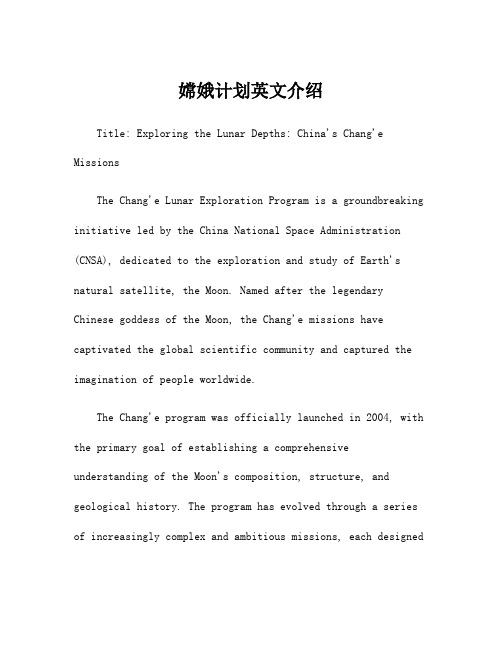
嫦娥计划英文介绍Title: Exploring the Lunar Depths: China's Chang'e MissionsThe Chang'e Lunar Exploration Program is a groundbreaking initiative led by the China National Space Administration (CNSA), dedicated to the exploration and study of Earth's natural satellite, the Moon. Named after the legendary Chinese goddess of the Moon, the Chang'e missions have captivated the global scientific community and captured the imagination of people worldwide.The Chang'e program was officially launched in 2004, with the primary goal of establishing a comprehensive understanding of the Moon's composition, structure, and geological history. The program has evolved through a series of increasingly complex and ambitious missions, each designedto push the boundaries of lunar exploration and contribute to the advancement of human knowledge.Chang'e-1: Laying the GroundworkThe first mission in the Chang'e series, Chang'e-1, was launched in 2007. This orbiter spacecraft was designed to conduct a comprehensive survey of the lunar surface, mapping its topography, composition, and gravitational field. The mission also aimed to test and demonstrate the technical capabilities required for future lunar exploration, including autonomous navigation, long-distance communications, and advanced scientific instrumentation.During its 15-month operational lifespan, Chang'e-1 successfully achieved its primary objectives, providing valuable data and insights that laid the foundation for subsequent missions. The spacecraft's high-resolution camera captured detailed images of the lunar surface, offering newperspectives on the Moon's geological features and potential resources.Chang'e-2: Expanding the ExplorationBuilding upon the success of Chang'e-1, the Chang'e-2 mission was launched in 2010. This advanced orbiter was designed to conduct higher-resolution surveys of the lunar surface, with a particular focus on potential landing sites for future missions. The spacecraft's advanced sensors and cameras allowed it to capture detailed maps of the lunar landscape, including previously unexplored regions.One of the key achievements of Chang'e-2 was its exploration of the Earth-Moon Lagrange Point L2, an area of gravitational stability located approximately 65,000 kilometers beyond the far side of the Moon. This landmark event demonstrated China's technological prowess and paved the way for future deep-space missions.Chang'e-3: Landing on the MoonThe Chang'e-3 mission, launched in 2013, marked a significant milestone in China's lunar exploration program. This mission included both an orbiter and a lander, the latter of which successfully touched down on the lunar surface, making China the third country after the United States and the Soviet Union to achieve a soft landing on the Moon.The Chang'e-3 lander, equipped with a variety of scientific instruments, conducted in-depth studies of the landing site, known as the Sinus Iridum (Bay of Rainbows). The mission's highlight was the deployment of the Yutu (Jade Rabbit) rover, which traversed the lunar surface, gathering valuable data on the Moon's geology, soil composition, and potential resources.The Chang'e-3 mission not only demonstrated China's technological capabilities but also provided a wealth ofscientific data that advanced our understanding of the Moon's structure and evolution.Chang'e-4: Exploring the Far SideThe Chang'e-4 mission, launched in 2018, represented a groundbreaking achievement in lunar exploration. This mission was the first to successfully land a spacecraft on the far side of the Moon, a region that had previously remained unexplored due to the challenges of direct communication and navigation.The Chang'e-4 lander and its accompanying Yutu-2 rover landed in the Von Kármán crater, located within the South Pole-Aitken basin, the largest and oldest known impact crater in the solar system. The mission's objectives included conducting geological and biological experiments, as well as testing the effects of the lunar environment on various materials and organisms.One of the key achievements of the Chang'e-4 mission was the deployment of the Queqiao relay satellite, which enabled direct communication between the far side of the Moon and Earth, overcoming the communication challenges posed by the Moon's geography.The data and insights gathered by the Chang'e-4 mission have provided unprecedented insights into the far side of the Moon, revolutionizing our understanding of the lunar environment and paving the way for future, more ambitious exploration efforts.Chang'e-5: Bringing Moon Rocks Back to EarthThe most recent mission in the Chang'e series, Chang'e-5, achieved another historic milestone in 2020. This complex mission involved the successful collection of lunar samples and their safe return to Earth, marking the first time in over 40 years that lunar material had been brought back to our planet.The Chang'e-5 mission consisted of four key components:an orbiter, a lander, an ascent vehicle, and a re-entry capsule. The lander touched down in the Oceanus Procellarum (Ocean of Storms) region, where it collected approximately 2 kilograms of lunar soil and rock samples. These samples were then transferred to the ascent vehicle, which launched fromthe lunar surface and docked with the orbiter in lunar orbit.The final stage of the mission involved the re-entry capsule, which safely landed in China's Inner Mongolia region, allowing scientists to study the precious lunar material and gain new insights into the Moon's formation and evolution.The Chang'e-5 mission not only demonstrated China's technological prowess but also opened up new avenues for collaborative scientific research, as the collected samples have been made available to the global scientific communityfor further analysis and study.The Future of the Chang'e ProgramThe Chang'e program's ambitious exploration of the Moon has captivated the world and solidified China's position as a leading player in the field of lunar exploration. The program's success has paved the way for even more ambitious plans, including the potential establishment of a permanent lunar research station and the exploration of the Moon's polar regions.As the Chang'e program continues to evolve, the international scientific community eagerly awaits theinsights and discoveries that will undoubtedly emerge from these groundbreaking missions. The program's contributions to our understanding of the Moon's history, composition, and potential resources are invaluable, and its legacy will undoubtedly inspire future generations of space explorers and researchers.。
英语Presentation(嫦娥探月工程)
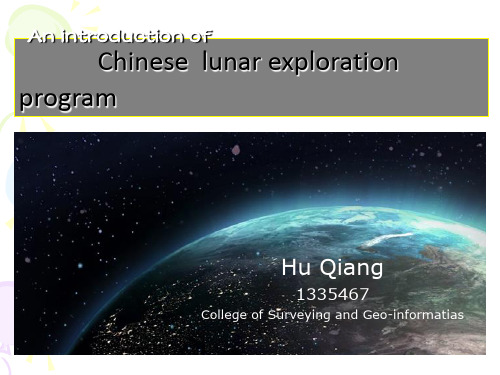
• A man named Wanhu in Ming Dynasty wanted to fly to the sky but he failed and dead.
How to realize the dream?
With the dream and the technology, our brave Chinese people have never stopped the pace of advancing in the waves of human exploration into space.
In just half a century, China has made remarkable success.
The plan of the program
Our lunar exploration program " The Chang'e Program " started in 2004. China's lunar exploration program consists of,chang’e II flied into space with the hope of Chinese people, which attracted worldwide attention. Exploration satellite that carried high-resolution cameras tested key technologies to provide HD photo for the landing of Chang’e III.
HD photo of Dan Nie Er crater (丹聂耳 撞击坑)
local image maps of the Sinus Iridum (虹湾) , the Pre-landing zone of the chang’e III
中国探月工程英语作文
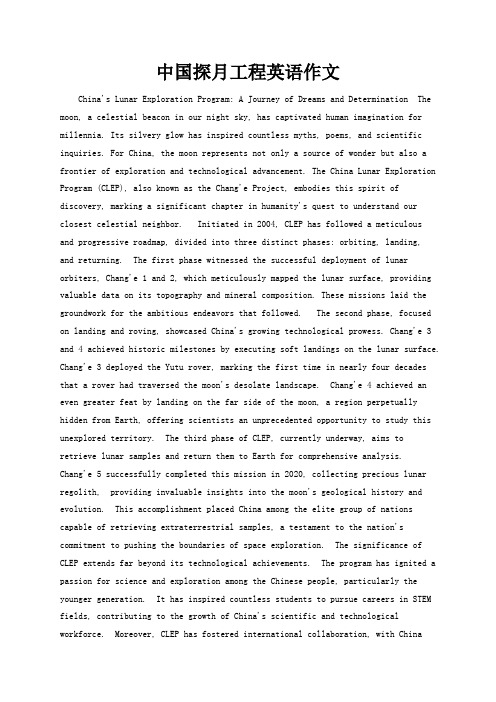
中国探月工程英语作文China's Lunar Exploration Program: A Journey of Dreams and Determination The moon, a celestial beacon in our night sky, has captivated human imagination for millennia. Its silvery glow has inspired countless myths, poems, and scientific inquiries. For China, the moon represents not only a source of wonder but also a frontier of exploration and technological advancement. The China Lunar Exploration Program (CLEP), also known as the Chang'e Project, embodies this spirit of discovery, marking a significant chapter in humanity's quest to understand our closest celestial neighbor. Initiated in 2004, CLEP has followed a meticulousand progressive roadmap, divided into three distinct phases: orbiting, landing,and returning. The first phase witnessed the successful deployment of lunar orbiters, Chang'e 1 and 2, which meticulously mapped the lunar surface, providing valuable data on its topography and mineral composition. These missions laid the groundwork for the ambitious endeavors that followed. The second phase, focusedon landing and roving, showcased China's growing technological prowess. Chang'e 3 and 4 achieved historic milestones by executing soft landings on the lunar surface. Chang'e 3 deployed the Yutu rover, marking the first time in nearly four decadesthat a rover had traversed the moon's desolate landscape. Chang'e 4 achieved an even greater feat by landing on the far side of the moon, a region perpetually hidden from Earth, offering scientists an unprecedented opportunity to study this unexplored territory. The third phase of CLEP, currently underway, aims toretrieve lunar samples and return them to Earth for comprehensive analysis.Chang'e 5 successfully completed this mission in 2020, collecting precious lunar regolith, providing invaluable insights into the moon's geological history and evolution. This accomplishment placed China among the elite group of nations capable of retrieving extraterrestrial samples, a testament to the nation's commitment to pushing the boundaries of space exploration. The significance of CLEP extends far beyond its technological achievements. The program has ignited a passion for science and exploration among the Chinese people, particularly the younger generation. It has inspired countless students to pursue careers in STEM fields, contributing to the growth of China's scientific and technological workforce. Moreover, CLEP has fostered international collaboration, with Chinapartnering with other nations on various lunar research initiatives, highlighting the importance of global cooperation in unraveling the mysteries of the cosmos. Looking ahead, China's lunar ambitions continue to soar. Plans are underway for future missions, including the establishment of a lunar research station and even the possibility of crewed missions to the moon. These endeavors reflect China'slong-term vision of becoming a major spacefaring nation, contributingsignificantly to humanity's understanding of the universe and our place within it. The China Lunar Exploration Program stands as a testament to human ingenuity, perseverance, and the unwavering pursuit of knowledge. As China continues itslunar odyssey, the world watches with anticipation, eager to witness the next chapter in this remarkable journey of exploration and discovery.。
英语讲嫦娥奔月的故事

英语讲嫦娥奔月的故事Long, long ago in ancient China, there lived a beautiful woman named Chang'e. She was the wife of a brave and talented archer named Hou Yi. The two of them were deeply in love and lived a happy and peaceful life.However, their peaceful existence was soon disrupted by a series of events that would change their lives forever. One day, the world was in great turmoil as ten suns had risen in the sky, scorching the earth and causing great havoc. People were suffering, and crops were withering in the heat. The Emperor of Heaven summoned Hou Yi, a skilled and renowned archer, to help save the world.Hou Yi bravely accepted the challenge and set out to shoot down nine of the ten suns, leaving only one to provide light and warmth for the world. He succeeded in his mission, and the people were grateful and relieved. Hou Yi became a hero, and his name was celebrated throughout the land.However, fame and glory did not bring Hou Yi true happiness. He longed to be reunited with his beloved wife, Chang'e, whom he missed dearly. To ease his sorrow, Hou Yi sought out the advice of a wise and powerful immortal, who gifted him with a special elixir that would grant him immortality.Hou Yi intended to share the elixir with Chang'e so they could both live forever and be together for all eternity. However, as he was out hunting, his apprentice, Peng Meng, discovered the elixir and attempted to steal it for himself. When Chang'e realized what was happening, she swallowed the elixir to prevent it from falling into the wrong hands.To her surprise, Chang'e did not die, but instead, she began to feel lighter and lighter until she floated up into the sky. Hou Yi arrived home to find his wife soaring towards the heavens, and he called out to her in distress. Chang'e didn't want to leave him, but the elixir's magic was too strong, and she soon found herself on the moon, where she would remain for eternity.Heartbroken and unable to be with his beloved wife, Hou Yi began to offer her favorite foods as sacrifices to the moon, hoping to show his love and devotion. From then on, people began to worship the moon and celebrate the Mid-Autumn Festival in honor of Chang'e.Chang'e, now a goddess of the moon, spent her days on the moon, accompanied by the Jade Rabbit, who was tasked with pounding the elixir of immortality in his mortar and pestle. It is said that those who gaze at the moon can see her silhouette, a reminder of the undying love between Hou Yi and Chang'e.And so, the legend of Chang'e, the Goddess of the Moon, has been passed down through generations, inspiring countless poems, songs, and celebrations. Every year, during the Mid-Autumn Festival, people come together to gaze at the moon, offer sacrifices, and give thanks for the love and unity in their lives.The story of Chang'e serves as a reminder of the enduring power of love, the importance of sacrifice, and the timeless beauty of the moon that illuminates our lives. And as the moon continues to shine in the night sky, we are reminded of the love and devotion that transcends time and space, just like the story of Hou Yi and Chang'e.。
嫦娥五号展览英语作文
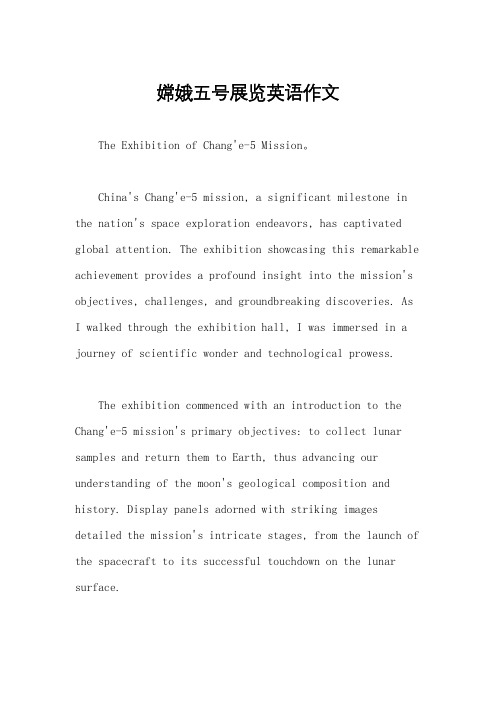
嫦娥五号展览英语作文The Exhibition of Chang'e-5 Mission。
China's Chang'e-5 mission, a significant milestone in the nation's space exploration endeavors, has captivated global attention. The exhibition showcasing this remarkable achievement provides a profound insight into the mission's objectives, challenges, and groundbreaking discoveries. As I walked through the exhibition hall, I was immersed in a journey of scientific wonder and technological prowess.The exhibition commenced with an introduction to the Chang'e-5 mission's primary objectives: to collect lunar samples and return them to Earth, thus advancing our understanding of the moon's geological composition and history. Display panels adorned with striking images detailed the mission's intricate stages, from the launch of the spacecraft to its successful touchdown on the lunar surface.One of the highlights of the exhibition was a meticulously crafted replica of the Chang'e-5 spacecraft. As I marveled at its intricate design, I couldn't help but admire the ingenuity and precision behind its construction. The spacecraft's innovative technology, including its autonomous landing capabilities and sample collection mechanisms, underscored China's prowess in space exploration.Another fascinating aspect of the exhibition was the display of lunar samples brought back by the Chang'e-5 mission. Encased in protective glass, these precious specimens offered a rare glimpse into the moon's geological history. Scientists meticulously analyzed these samples, unraveling mysteries that had long eluded human understanding.In addition to showcasing the scientific achievements of the mission, the exhibition also highlighted the collaborative efforts of scientists, engineers, and researchers involved in its success. Interactive displays allowed visitors to experience firsthand the challenges ofoperating in the harsh environment of space, fostering a deeper appreciation for the dedication and perseverance of those involved in the mission.Furthermore, the exhibition shed light on the broader implications of the Chang'e-5 mission for future space exploration endeavors. By demonstrating the feasibility of lunar sample return missions, China has paved the way for future scientific discoveries and potential lunar colonization efforts. The mission's success has inspired a new generation of scientists and engineers to push the boundaries of space exploration further.As I concluded my visit to the Chang'e-5 exhibition, I couldn't help but feel a sense of pride in China's achievements in space exploration. The mission's success not only represents a significant milestone for the nation but also serves as a testament to the power of human ingenuity and collaboration in unlocking the mysteries of the universe. Indeed, the legacy of Chang'e-5 will endure for generations to come, inspiring future explorers to reach for the stars.In conclusion, the Chang'e-5 exhibition offers a comprehensive and captivating glimpse into one of China's most remarkable space exploration missions. From the intricacies of spacecraft design to the analysis of lunar samples, the exhibition showcases the awe-inspiring achievements of the mission and their implications for the future of space exploration. As I left the exhibition hall, I couldn't help but feel a renewed sense of wonder and excitement for the boundless possibilities that lie beyond the stars.。
嫦娥五号探月英语作文
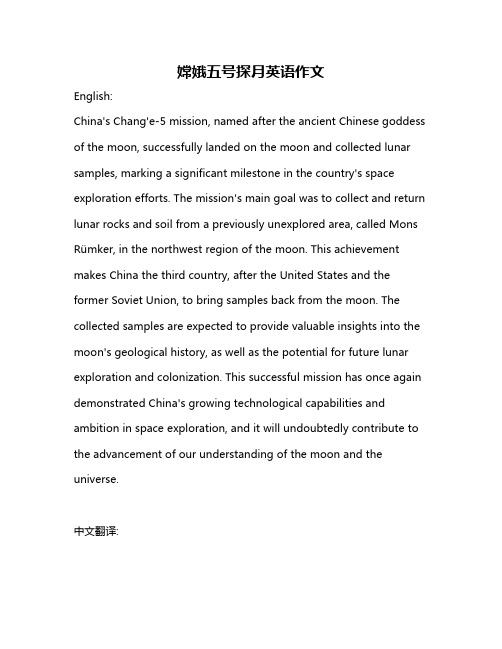
嫦娥五号探月英语作文English:China's Chang'e-5 mission, named after the ancient Chinese goddess of the moon, successfully landed on the moon and collected lunar samples, marking a significant milestone in the country's space exploration efforts. The mission's main goal was to collect and return lunar rocks and soil from a previously unexplored area, called Mons Rümker, in the northwest region of the moon. This achievement makes China the third country, after the United States and the former Soviet Union, to bring samples back from the moon. The collected samples are expected to provide valuable insights into the moon's geological history, as well as the potential for future lunar exploration and colonization. This successful mission has once again demonstrated China's growing technological capabilities and ambition in space exploration, and it will undoubtedly contribute to the advancement of our understanding of the moon and the universe.中文翻译:中国的嫦娥五号任务以古代中国月神的名字命名,成功在月球着陆并采集了月球样本,标志着该国探索太空的努力取得了重要的里程碑。
嫦娥四号英语作文
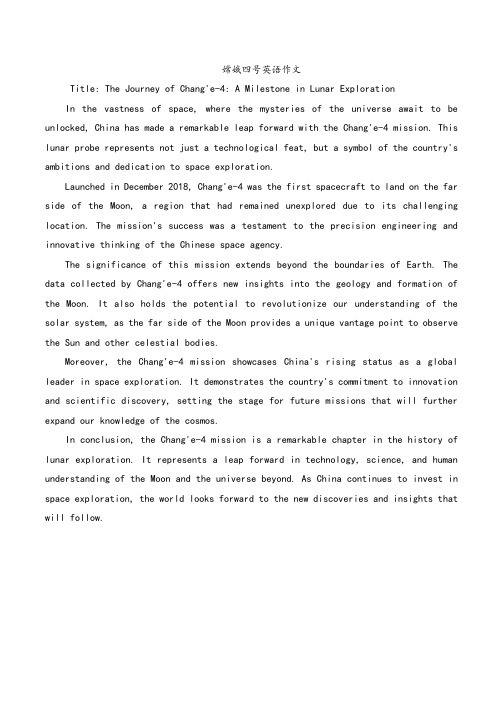
嫦娥四号英语作文Title: The Journey of Chang'e-4: A Milestone in Lunar ExplorationIn the vastness of space, where the mysteries of the universe await to be unlocked, China has made a remarkable leap forward with the Chang'e-4 mission. This lunar probe represents not just a technological feat, but a symbol of the country's ambitions and dedication to space exploration.Launched in December 2018, Chang'e-4 was the first spacecraft to land on the far side of the Moon, a region that had remained unexplored due to its challenging location. The mission's success was a testament to the precision engineering and innovative thinking of the Chinese space agency.The significance of this mission extends beyond the boundaries of Earth. The data collected by Chang'e-4 offers new insights into the geology and formation of the Moon. It also holds the potential to revolutionize our understanding of the solar system, as the far side of the Moon provides a unique vantage point to observe the Sun and other celestial bodies.Moreover, the Chang'e-4 mission showcases China's rising status as a global leader in space exploration. It demonstrates the country's commitment to innovation and scientific discovery, setting the stage for future missions that will further expand our knowledge of the cosmos.In conclusion, the Chang'e-4 mission is a remarkable chapter in the history of lunar exploration. It represents a leap forward in technology, science, and human understanding of the Moon and the universe beyond. As China continues to invest in space exploration, the world looks forward to the new discoveries and insights that will follow.。
嫦娥发射英语作文
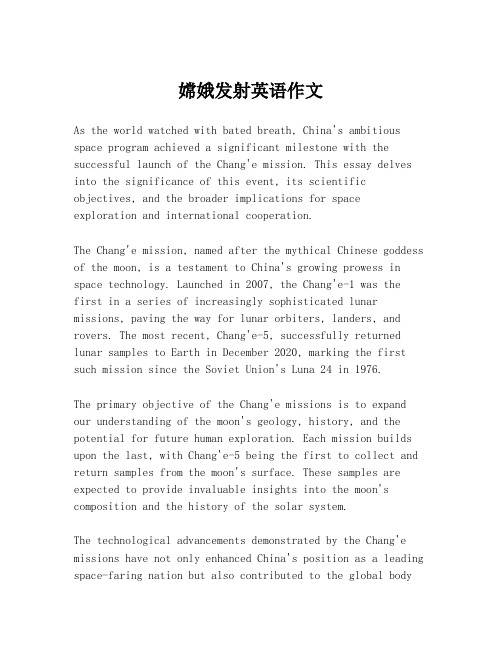
嫦娥发射英语作文As the world watched with bated breath, China's ambitious space program achieved a significant milestone with the successful launch of the Chang'e mission. This essay delves into the significance of this event, its scientific objectives, and the broader implications for space exploration and international cooperation.The Chang'e mission, named after the mythical Chinese goddess of the moon, is a testament to China's growing prowess in space technology. Launched in 2007, the Chang'e-1 was thefirst in a series of increasingly sophisticated lunar missions, paving the way for lunar orbiters, landers, and rovers. The most recent, Chang'e-5, successfully returned lunar samples to Earth in December 2020, marking the first such mission since the Soviet Union's Luna 24 in 1976.The primary objective of the Chang'e missions is to expand our understanding of the moon's geology, history, and the potential for future human exploration. Each mission builds upon the last, with Chang'e-5 being the first to collect and return samples from the moon's surface. These samples are expected to provide invaluable insights into the moon's composition and the history of the solar system.The technological advancements demonstrated by the Chang'e missions have not only enhanced China's position as a leading space-faring nation but also contributed to the global bodyof knowledge in space science. The missions have utilized advanced robotics, navigation systems, and autonomous landing technologies, all of which are crucial for future deep-space exploration.Moreover, the Chang'e missions have sparked international interest and collaboration. Space agencies around the world have expressed a desire to work with China on lunar and deep-space exploration projects. This spirit of cooperation is essential for the sustainable development of space technology and the pursuit of knowledge about the cosmos.In conclusion, the Chang'e mission represents a significant step forward in our quest to explore the moon and the wider universe. It showcases the importance of investing in space research and the benefits of international collaboration inthe pursuit of scientific discovery. As we look to the future, the lessons learned from Chang'e will undoubtedly play acrucial role in shaping the next generation of space exploration initiatives.。
嫦娥计划英文介绍

嫦娥计划英文介绍English:The Chang'e program, also known as the Chinese Lunar Exploration Program, is a series of robotic missions by the China National Space Administration (CNSA) aimed at exploring the Moon. Named after the Chinese goddess of the Moon, Chang'e, the program has seen a series of successful missions starting with Chang'e 1 in 2007. The program aims to achieve several goals such as studying the lunar environment, conducting scientific experiments, and eventually establishing a long-term Chinese presence on the Moon. The most notable missions under the Chang'e program include the Chang'e 3 mission which successfully landed a rover on the Moon in 2013, and the Chang'e 4 mission which made the first ever soft landing on the far side of the Moon in 2019. The Chang'e program is considered a significant milestone in China's space exploration efforts and has brought the country to the forefront of lunar exploration.中文翻译:嫦娥工程,也被称为中国探月工程,是中国国家航天局(CNSA)发起的一系列探索月球的机器人任务。
- 1、下载文档前请自行甄别文档内容的完整性,平台不提供额外的编辑、内容补充、找答案等附加服务。
- 2、"仅部分预览"的文档,不可在线预览部分如存在完整性等问题,可反馈申请退款(可完整预览的文档不适用该条件!)。
- 3、如文档侵犯您的权益,请联系客服反馈,我们会尽快为您处理(人工客服工作时间:9:00-18:30)。
summary
Chinese spaceflight experienced from scratch, from weak to strong . In this process it reflected many kinds of spirits. The most affect me is the self-reliance, In my opinion, we should apply this spirit to our daily life . It will make us stronger . Finally, I wish Chinese space industry achieved more brilliant achievements.
orbiters (绕) landers and rovers(落) automated sample return(回)
October 24, 2007, Chang‘e I was successfully launched. This is the third milestone of China's space activities, and marking that the Chinese lunar exploration program has taken the first step.
Reasons
Physical resources Scientific research Science and Technology breakthrough Other opportunities in the future
the
reason of success about
Chinese lunar exploration program
The orbits of the probe
landing on the moon
On December 14 , Chang'e-3 landed on the moon's surface, marking that China become the third country in the world to carry out such a rover mission after the United States and former Soviet Union. And the rover Yutu touched the lunar surface at the next morning.
In just half a century, China has made remarkable success.
The plan of the program
Our lunar exploration program " The Chang'e Program " started in 2004. China's lunar exploration program consists of three phases:
Why do we explore the moon?
The lunar exploration program spend a huge number of money, but in our country there are still many people are on the verge of poverty, many child don’t have the money to go to school , why do we spend a lot of money to explore the moon ?
October 1,2010,chang’e II flied into space with the hope of Chinese people, which attracted worldwide attention. Exploration satellite that carried high-resolution cameras tested key technologies to provide HD photo for the landing of Chang’e III.
An introduction of
Chinese lunar exploration program
Hu Qiang
1335467
College of Surveying and Geo-informatias
Begin with the Legend of Chang’e
• The story of Chang ’e is a famous legend about the moon in China.
Best wishes to Chang’e 3 mission and our country!
The Chang’e 3 mission
Carry out some tasks that so far haven’t been done by any other country in the world.
The plans
After the unmanned lunar exploration project is completed, China will carry out the manned exploration, and gradually build a moon base with relevant countries.
• A man named Wanhu in Ming Dynasty wanted to fly to the sky but he failed and dead.
How to realize the dream?
With the dream and the technology, our brave Chinese people have never stopped the pace of advancing in the waves of human exploration into space.
Great designs and great consideration People’ support Financial ensurance Excellent scientists and Consummate cooperation Independent development (the most important reason)
HD photo of Dan Nie Er crater (丹聂耳 撞击坑)
local image maps of the Sinus Iridum (虹湾) , the Pre-landing zone of the chang’e III
Chang'e-3 lunar probe
On December 2 , we successfully launched the Chang'e-3 lunar probe. It is the latest step in China’s ambitious space program.
